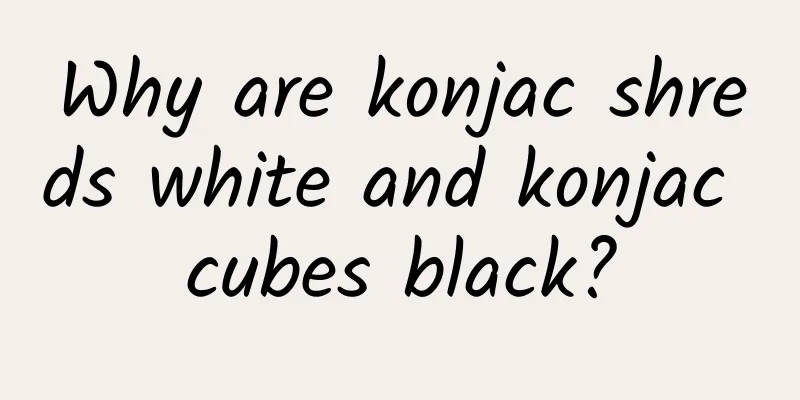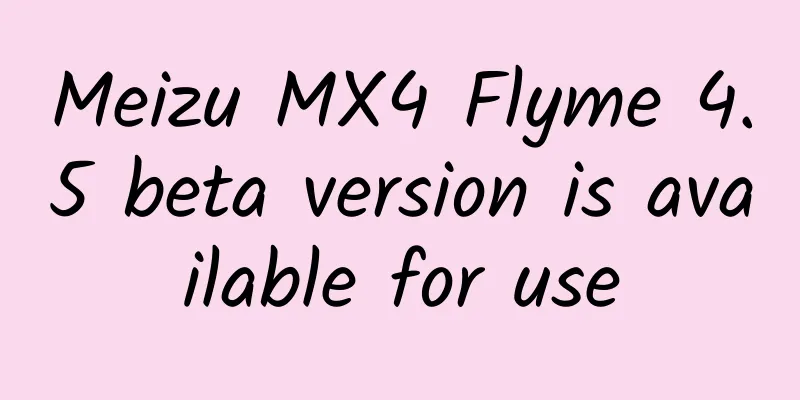Why are konjac shreds white and konjac cubes black?

|
Audit expert: Wang Guoyi Postdoctoral fellow in Nutrition and Food Safety, China Agricultural University Konjac is probably familiar to everyone. Especially for those who are losing weight, the konjac shreds and noodles sold on the market, the konjac cubes and knots commonly found in hot pot, etc. are all very familiar foods. Source: A shopping platform So what kind of plant is konjac? Why are konjac shreds white and konjac cubes black? What's so magical about it? Let's find out today. What exactly is konjac? Konjac, also known as konjac yam, demon yam, ghost konjac, konjac, is a perennial plant of the Araceae family, mainly produced in Asia, Europe and North America. The reason why its name is so magical is not only because of its strange appearance, but also because it is "poisonous" all over.
Konjac contains a large amount of alkaloids and is highly toxic. The most toxic part is the tuber of konjac, which cannot be eaten raw and must be specially processed before it can be eaten. The history of konjac consumption in my country can be traced back to more than 1,700 years ago. The "Shudu Fu" of the Western Jin Dynasty recorded how to eat konjac. It is speculated that the first people to eat konjac were the Yi people. They peeled the konjac, ground it repeatedly on a stone slab, and then boiled it in alkaline water for a long time. The resulting block can be eaten. Nowadays, konjac can be made into many forms and types of food. For example, it can be made into thin filaments of konjac, which have a smooth taste and are usually used for cold dishes, hot pots or stir-frying. It can also be cut into blocks. Compared with konjac filaments, konjac blocks are more solid and have a slightly chewy taste. They can absorb the taste of soup and are suitable for hot pots and stews. Konjac powder can also be made into a gelatinous state, cut into strips or blocks, and made into cold dishes or jelly with seasonings. There are many ways to cook konjac. After people's exploration, konjac has become more and more a regular on our dining tables. Why are konjac shreds white and konjac cubes black? Many of you may have noticed that although both are konjac products, the appearance of konjac shreds and konjac cubes are quite different: the former is in the shape of white thin noodles, while the latter is a black block with a certain thickness and width. So why do the two have completely different colors? The answer lies in the difference in the processing methods of the two. Konjac cubes source: Wikipedia/Gleam The production process of konjac cubes is relatively complicated: first, wash and peel the konjac, then cut it into blocks of appropriate size and rinse it in clean water. This process will initially remove some of the starch and impurities in the konjac. Next, soak the konjac cubes in clean water. The soaking process usually takes several hours or overnight. Substances such as polysaccharides will gradually be dissolved and washed away with the water. Next, put the soaked konjac cubes into a steamer and make them soft through high-temperature cooking. It is particularly important to emphasize that through the boiling process, the oxalic acid in the konjac will dissolve and release in the water. At this point, most of the impurities in the konjac have been removed. The next step is to use a press to remove excess water and make the konjac blocks more compact. Next, the squeezed konjac blocks are placed in a ventilated and dry place to dry in order to remove the remaining water and promote oxidation and fermentation of the konjac blocks. During the drying process, the konjac blocks are exposed to the air and come into contact with oxygen to undergo an oxidation reaction, which also makes the konjac darker in color. Finally, the konjac blocks are cut into appropriate sizes and can be eaten or further processed. Konjac cubes source: pexels In contrast, the production process of konjac shreds is relatively simple: first, wash and peel the konjac, then cut it into thin filaments and rinse it in clean water. Next, boil it in boiling water for 2-3 minutes to make the konjac shreds transparent and soft, so as to remove the oxalic acid and most of the starch in the konjac. After that, take out the konjac shreds, soak and rinse them in cold water to remove excess starch and impurities. Finally, drain the water, and the konjac shreds are ready. The entire production process does not involve steps such as steaming, pressing and drying. By analyzing the production process of the two, we can see that the colors of konjac silk and konjac cubes are different for two reasons: The first reason is that the ingredients of the two are not exactly the same. The main components of konjac are fiber and starch. The fiber part is relatively white, while the starch part contains other ingredients and pigments and is darker in color. Konjac shreds need to maintain a soft texture, so the production mainly focuses on extracting the fiber part of the konjac . A large part of the starch is removed during the blanching process, so it is white; while konjac blocks require a firm texture and a formed block appearance. The starch reacts with water during the cooking process to form a gel-like substance. This gel can bond the fiber structure of the konjac block, giving the konjac block a firm shape and taste. Therefore, the production of konjac blocks needs to retain both starch and fiber , which also leads to the relatively dark color of the konjac blocks. The second reason is the oxidation reaction of konjac chunks. Konjac chunks usually go through a drying and fermentation stage during the production process. During the drying process, the konjac chunks are exposed to the air and come into contact with oxygen, causing the polyphenols in the konjac to undergo an oxidation reaction, resulting in a color change, making the konjac chunks appear black or dark gray . Konjac silk, on the other hand, does not usually go through drying and fermentation during the production process, so a similar oxidation reaction does not occur. White and orange konjac chips Source: Wikipedia/woinary Therefore, the difference in color of konjac products depends on many factors and is not strictly related to the appearance of konjac products. White konjac products are mainly due to more processing to remove starch and impurities, while black or dark gray konjac products are due to oxidation reactions and starch content during drying and fermentation. Is it reliable to eat konjac to lose weight? On major shopping platforms and WeChat public accounts, when searching for "konjac", the results usually come with the function of weight loss. Many people have doubts about this: Can eating konjac really help you lose weight? Today, I can tell you with certainty that eating konjac is really beneficial for weight loss! The main reasons are as follows: Low in calories and high in dietary fiber Konjac is a low-calorie food with high water content and relatively low calories. In addition, konjac is rich in dietary fiber, which can increase satiety, reduce appetite, and help control the total amount of food intake, thereby helping to reduce calorie intake. Reduce energy absorption The dietary fiber in konjac has a certain viscosity and can form a colloid-like substance. This colloid can slow down the digestion and absorption of food in the gastrointestinal tract, reduce the digestion and absorption rate of other nutrients in food (such as glucose and fat), and reduce calorie intake. Regulates blood sugar and cholesterol levels The dietary fiber in konjac can slow down the digestion of carbohydrates in food and the release of sugar, thereby smoothly regulating blood sugar levels. In addition, dietary fiber can also bind cholesterol, help eliminate excess cholesterol in the body, and help regulate blood lipid and cholesterol levels. It should be noted that konjac itself does not have a direct fat-burning effect . The effect of weight loss still needs to be considered in combination with diet structure, exercise and overall lifestyle. Konjac can be used as a low-calorie, high-fiber food. As part of the diet, it helps control calorie intake and increase satiety, thus playing a certain auxiliary role in the weight loss process. Konjac noodles source: a shopping website However, we should also be aware that excessive consumption of konjac may cause a large amount of dietary fiber to absorb water and swell in the intestines, increase the pressure in the intestinal cavity, cause gastrointestinal discomfort, and thus lead to indigestion; the dietary fiber in konjac has a certain viscosity, which can bind some minerals and trace elements, interfering with their absorption and utilization in the intestines; konjac is a low-calorie, low-nutrient-density food. Excessive reliance on konjac as the main food source may lead to insufficient nutrient intake, lack of other important nutrients such as protein, fat, and various vitamins and minerals, and long-term nutritional imbalance may have a negative impact on physical health. In short, excessive consumption of konjac may lead to digestive discomfort, nutritional deficiencies and other adverse reactions. Therefore, it is necessary to consume an appropriate amount of konjac reasonably and determine the amount of consumption according to personal circumstances and health conditions. Paying attention to a balanced diet and a variety of foods can help you enjoy the benefits of konjac and reduce potential discomfort or risks. |
<<: Man Jiang Hong, what is red?
>>: The way to achieve high image quality is to stack pixels together?
Recommend
2022 Spring Festival holiday weather: Many places in the north welcome the New Year in snow, and the south is wet and cold throughout the long holiday
Today is New Year's Eve Where do you spend th...
The high-end tablet instantly turns into a thermal imager
Usually when we review a product, we will have a ...
In order to improve performance, scientists actually "supplement" semiconductors with vitamin C?
Produced by: Science Popularization China Author:...
Take these Zhihu promotion and follower-increasing tips for free!
In the past two years, the Internet industry has ...
A usable brand planning template
If you have never written a brand planning propos...
Do 4S stores need to certify Douyin Blue V? How to get Blue V on Douyin?
As a representative of short video platforms, Dou...
The universal equation for product growth: number of users = user motivation / action cost
The article analyzes and explains the universal g...
Short video operation topic planning!
In this article, we will share with you from thre...
Xiaohongshu marketing promotion, 13 tips for hot-selling notes!
In January 2019, the number of Xiaohongshu users ...
Insomnia, irritability, frequent headaches...People with these symptoms should pay attention!
Expert of this article: Wang Li, attending physic...
[2014 WOT Shenzhen Station Lecturer Interview] Huo Dianyan: New technology is the core value of mobile games
From November 21 to 22, 2014, the 2014 WOT Global...
Designed in the late 1950s, the Blackbird is an absolute miracle in aviation history.
© National Air and Space Museum Leviathan Press: ...
With current human science and technology, can we completely destroy the earth?
This article is based on answering similar questi...



![[Smart Farmers] It’s hot, hot, hot! Here’s a “heat-proof cooling patch” for you](/upload/images/67f22c2b6b682.webp)





